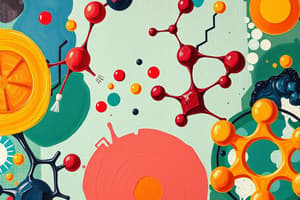Podcast
Questions and Answers
What are carbohydrates primarily classified as?
What are carbohydrates primarily classified as?
- Lipids
- Nucleic acids
- Polyhydroxy aldehydes or ketones (correct)
- Proteins
What are monosaccharides?
What are monosaccharides?
Polyhydroxy aldehydes or ketones that can’t easily be further hydrolyzed.
Sucrose = glucose + _______________
Sucrose = glucose + _______________
fructose
Maltose = glucose + ______________
Maltose = glucose + ______________
Lactose = glucose + ______________
Lactose = glucose + ______________
Which of the following is a homopolysaccharide?
Which of the following is a homopolysaccharide?
Structural isomers have different molecular formulas.
Structural isomers have different molecular formulas.
What are stereoisomers?
What are stereoisomers?
What is an example of a functional group isomer?
What is an example of a functional group isomer?
What is the empirical formula for many simpler carbohydrates?
What is the empirical formula for many simpler carbohydrates?
Study Notes
Carbohydrates
- The most common organic molecule found in nature
- They are the primary source of energy for most organisms
- They act as an energy storage form
- They can be structural components of many organisms
- They can be cell-membrane components that mediate intercellular communication
- Carbohydrates can be cell-surface antigens (ABO, MHC)
- They can be a part of the body’s extracellular ground substance
- They can be associated with proteins and lipids
- They are part of RNA, DNA, and several coenzymes (e.g NAD+, NADP+, FAD, CoA)
Features of Carbohydrates
- They are optically active polyhydroxy aldehydes or ketones
- They can be hydrolyzed to produce polyhydroxy aldehydes or ketones.
- Carbohydrates with an aldehyde group are known as Aldoses
- Carbohydrates with a ketone group are known as Ketoses
Types of Carbohydrates
- Monosaccharides: Polyhydroxy aldehydes or ketones that cannot be further hydrolyzed.
- Oligosaccharides: Polymers of 2-10 monosaccharides
- Polysaccharides: Polymers of > 10 monosaccharides
- Homopolysaccharide: A polymer of a single type of monosaccharide.
- Heteropolysaccharide: A polymer of least 2 types of monosaccharide.
Isomerism
- Structural Isomers: Compounds with the same molecular formula but different structures.
- Functional group isomers: Isomers with different functional groups
- Positional isomers: Isomers with substituent groups on different C-atoms.
- Stereoisomers: Compounds with same molecular formula, functional groups, and position of functional groups but with different conformations.
- cis-trans isomers: Isomers with different conformations around double bonds.
- Optical isomers: Isomers with different conformations around chiral or asymmetric carbon atoms.
Studying That Suits You
Use AI to generate personalized quizzes and flashcards to suit your learning preferences.
Related Documents
Description
This quiz covers the essential concepts related to carbohydrates, including their roles as energy sources, structural components, and their biochemical features. You will also learn about the different types of carbohydrates such as monosaccharides and oligosaccharides. Test your knowledge on these important organic molecules that are vital for many biological processes.





